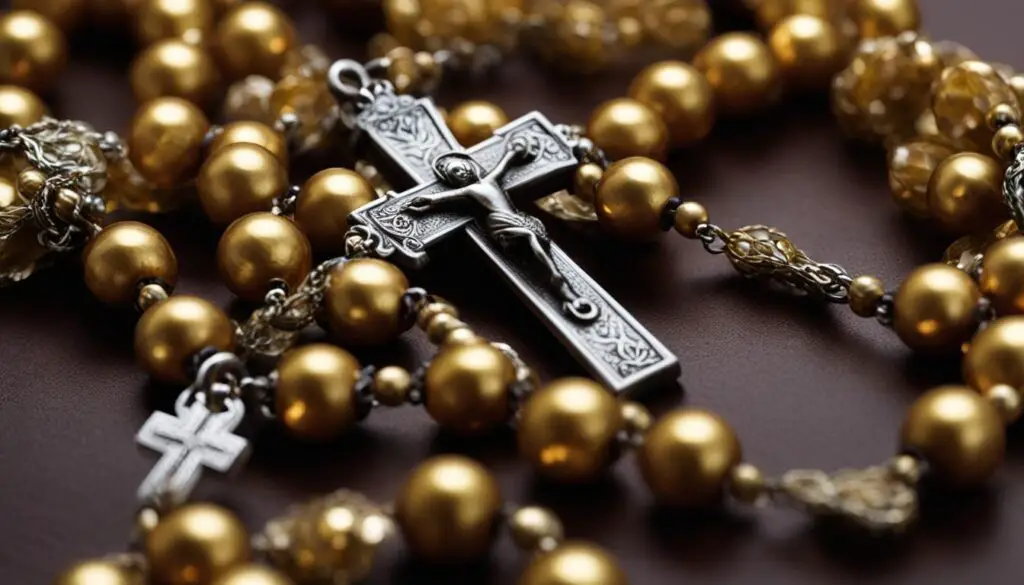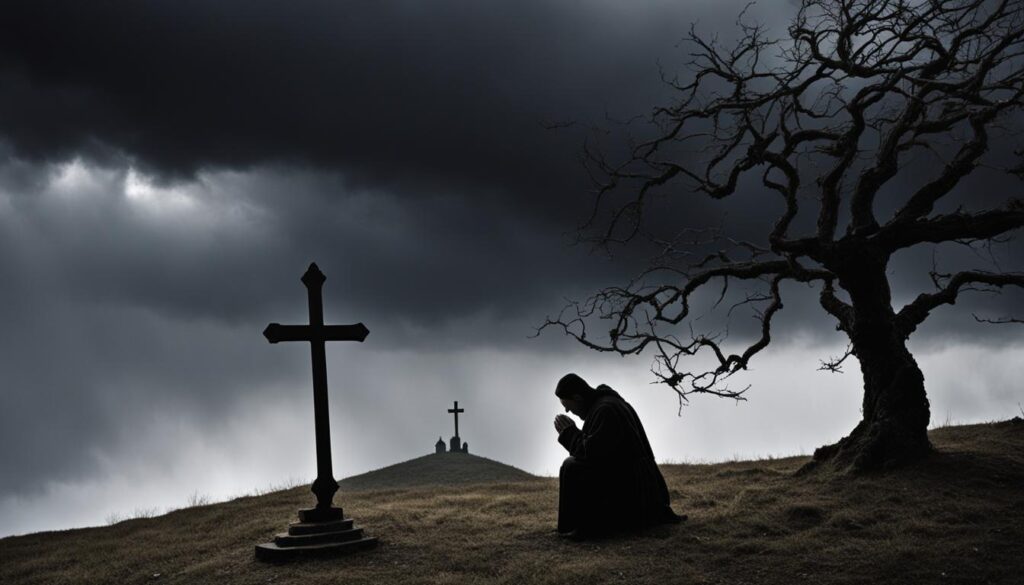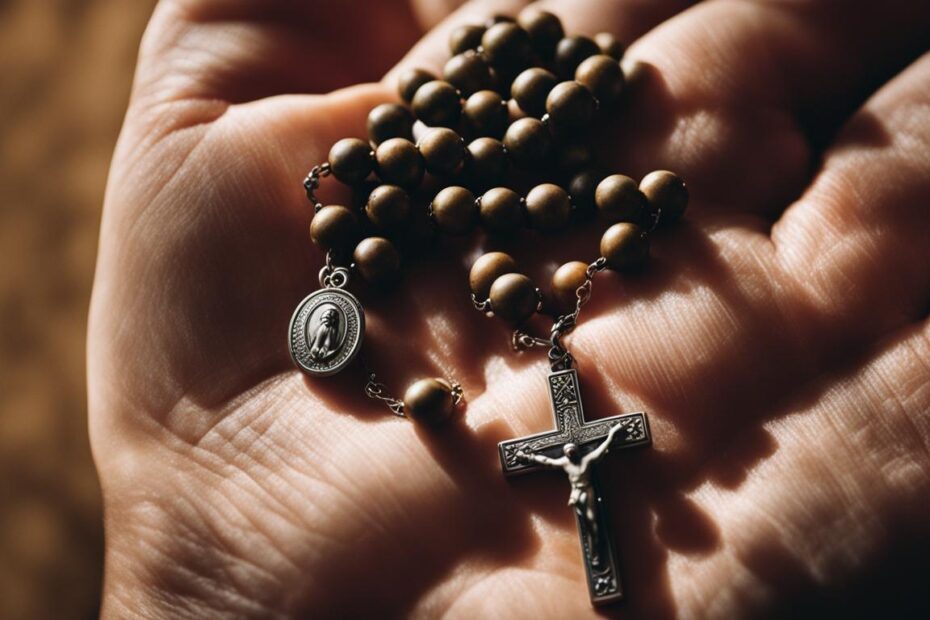Praying the Rosary is a cherished practice among Catholics, offering a way to communicate with God through recitation of prayers and reflection on the life of Jesus and Mary. If you’re new to the Catholic faith or simply looking to deepen your spiritual journey, learning how to pray the Catholic Rosary is a fundamental step. In this comprehensive guide, we will walk you through the step-by-step process of praying the Rosary, including the prayers and the order in which they are said.
Key Takeaways:
- Praying the Rosary is an essential practice for Catholics to communicate with God.
- The Rosary consists of specific prayers and meditations on the life of Jesus and Mary.
- Rosary beads are used as a physical tool to aid in concentration during prayer.
- There are four sets of mysteries to meditate on: Joyful, Sorrowful, Glorious, and Luminous.
- Consider incorporating the Divine Mercy Chaplet into your Rosary prayer routine.
The Significance of Rosary Beads in Catholic Prayer
Rosary beads hold a significant role in Catholic prayer, serving as a tangible aid to the faithful during their devotions. These beads, also known as Catholic prayer beads, are a physical tool that helps Catholics count their prayers and maintain focus during their spiritual practices. While the act of counting prayers may seem mundane to some, it holds deep symbolism and meaning within the Catholic tradition.
The use of rosary beads dates back centuries, with origins rooted in early monastic practices. The repetitive nature of the prayers recited using the beads allows the faithful to enter a state of contemplation and connection with God. Each bead represents a prayer, guiding the Catholic believer through a sequence of prayers that form the framework of the Rosary.
The use of rosary beads is also a form of Catholic devotion, as it acts as a physical reminder of one’s faith and commitment to prayer. By holding the beads and moving from one bead to the next, Catholics engage their senses and create a physical association with their spiritual practice. It serves as a tactile reminder of the presence of God and the intercession of Mary, inviting a deeper connection to the divine.

The Structure of Rosary Beads
A set of rosary beads typically consists of fifty-nine beads, including a crucifix or cross at one end and a medal of Mary or a saint at the other. The beads are divided into sections, known as decades, with each decade containing ten smaller beads. The larger beads, or the Our Father beads, separate the decades.
As Catholics pray the Rosary, they move their fingers along the beads, reciting specific prayers for each bead. The prayers include the Our Father, Hail Mary, and Glory Be. The combination of the physical act of holding the beads and the recitation of these prayers creates a deeply meditative experience, allowing the faithful to enter into a state of prayerful contemplation.
| Bead Type | Prayer |
|---|---|
| Crucifix/Cross | Begin with the Sign of the Cross |
| Our Father Beads | Recite the Our Father prayer |
| Decade Beads | Recite the Hail Mary prayer (10 times) |
| Spacer Beads | Recite the Glory Be prayer |
| Medal or Saint Bead | Conclude with a prayer to Mary or a saint |
By incorporating rosary beads into their prayer routines, Catholics are able to engage their physical senses and deepen their spirituality. The beads serve as a visual and tactile reminder of their faith, guiding them in their journey of prayer and contemplation.
The Basic Structure of the Rosary
Praying the Rosary involves a structured sequence of prayers and meditations. Understanding the basic structure is essential for those who are new to this powerful Catholic prayer practice. Here is a step-by-step guide on how to pray the Catholic Rosary:
- Start by holding the crucifix in your hand and making the Sign of the Cross, saying, “In the name of the Father, and of the Son, and of the Holy Spirit. Amen.”
- Recite the Apostles’ Creed, which is a statement of faith.
- Move on to the Our Father, also known as the Lord’s Prayer.
- Follow with three Hail Marys, as a way to honor the Virgin Mary.
- Recite the Glory Be, a prayer of praise to the Holy Trinity.
- Begin the first set of mysteries, either the Joyful, Sorrowful, Glorious, or Luminous mysteries.
- For each mystery, announce it, and then recite the Our Father.
- Follow with ten Hail Marys, known as a decade.
- After each decade, recite the Glory Be and the Fatima Prayer (“O my Jesus, forgive us our sins, save us from the fires of hell, lead all souls to Heaven, especially those in most need of Thy mercy.”)
- Repeat steps 7 to 9 for the remaining mysteries.
- Conclude the Rosary by reciting the Hail Holy Queen, a prayer honoring the Virgin Mary, and making the Sign of the Cross.
It’s important to note that the Rosary can be prayed individually or in a group setting. Many Catholics find the repetition of prayers soothing and meditative, allowing for a deeper connection with God and the intercession of Mary. The structure of the Rosary provides a framework that guides individuals in their prayer journey, helping them to focus on specific mysteries and reflect on the life of Jesus and Mary.
The Prayers of the Rosary
The prayers of the Rosary are an integral part of this Catholic devotion, serving as a means of connecting with God and honoring the Blessed Virgin Mary. They include the Our Father, the Hail Mary, and the Glory Be. Each of these prayers holds significant meaning and plays a specific role in the structure of the Rosary.
The Our Father, also known as the Lord’s Prayer, is a prayer that Jesus Himself taught His disciples. It serves as the opening prayer of the Rosary and sets the tone for the entire devotion. The Our Father is a powerful prayer that acknowledges God as our Father in heaven and expresses our dependence on Him for our daily needs.
The Hail Mary is a prayer that honors Mary, the Mother of Jesus, and seeks her intercession. It is a beautiful and profound prayer that consists of two parts. The first part is taken from the words of the Angel Gabriel and St. Elizabeth when they greeted Mary with the words, “Hail, full of grace, the Lord is with thee.” The second part is a simple request for Mary to pray for us, sinners, now and at the hour of our death.
The Glory Be, also known as the Doxology, is a prayer of praise to the Holy Trinity. It acknowledges the glory and majesty of God the Father, God the Son, and God the Holy Spirit. The Glory Be is traditionally recited after each decade of the Rosary, emphasizing our recognition and adoration of the Triune God.
These prayers form the backbone of the Rosary and create a rhythm of devotion that allows Catholics to enter into a deeper spiritual connection with God and Mary. Through the repetition of these prayers, Catholics aim to cultivate a spirit of contemplation, gratitude, and supplication, seeking to align their hearts and minds with God’s will.

The Mysteries of the Rosary
The Rosary is divided into four sets of mysteries: the Joyful Mysteries, the Sorrowful Mysteries, the Glorious Mysteries, and the Luminous Mysteries. Each set of mysteries corresponds to different events in the lives of Jesus and Mary. Catholics meditate on these mysteries while reciting the prayers of the Rosary to deepen their understanding and connection to the life of Christ.
Joyful Mysteries
The Joyful Mysteries focus on the events surrounding the birth and early life of Jesus. They include the Annunciation, the Visitation, the Nativity, the Presentation, and the Finding of Jesus in the Temple. Catholics reflect on these mysteries while reciting the prayers of the Rosary to contemplate the joys and blessings brought forth by Jesus’ incarnation.
Sorrowful Mysteries
The Sorrowful Mysteries center around the passion and death of Jesus. They include the Agony in the Garden, the Scourging at the Pillar, the Crowning with Thorns, the Carrying of the Cross, and the Crucifixion. Catholics reflect on these mysteries while reciting the prayers of the Rosary to meditate on the sacrifice and love of Jesus.
Glorious Mysteries
The Glorious Mysteries focus on the resurrection and the glory of Jesus and Mary. They include the Resurrection, the Ascension, the Descent of the Holy Spirit, the Assumption of Mary, and the Coronation of Mary. Catholics reflect on these mysteries while reciting the prayers of the Rosary to contemplate the triumph and exaltation of Christ and Mary.
Luminous Mysteries
The Luminous Mysteries were introduced by Pope St. John Paul II and highlight significant events in the public ministry of Jesus. They include the Baptism in the Jordan, the Wedding Feast at Cana, the Proclamation of the Kingdom, the Transfiguration, and the Institution of the Eucharist. Catholics reflect on these mysteries while reciting the prayers of the Rosary to deepen their understanding of Jesus’ teachings and miracles.

Meditating on the Joyful Mysteries
The Joyful Mysteries of the Rosary invite Catholics to reflect on the significant events surrounding the birth and early life of Jesus. These mysteries are a source of joy and gratitude as they highlight the blessings brought forth by Jesus’ incarnation.

The Annunciation
The Annunciation is the first Joyful Mystery and recalls the angel Gabriel’s visit to the Virgin Mary, announcing that she would conceive and bear the Son of God. Catholics meditate on Mary’s humble acceptance of God’s plan and her willingness to become the Mother of Jesus.
The Visitation
The Visitation is the second Joyful Mystery and tells the story of Mary’s visit to her relative Elizabeth, who was also miraculously expecting a child. Catholics contemplate Mary’s act of charity and how she carried the unborn Jesus within her, sharing His presence with others.
The Nativity
The Nativity is the third Joyful Mystery and commemorates the birth of Jesus in Bethlehem. Catholics reflect on the humble circumstances of Jesus’ birth, where He was laid in a manger, surrounded by Mary, Joseph, and adoring shepherds.
The Presentation
The Presentation is the fourth Joyful Mystery and recalls the offering of the infant Jesus in the temple by Mary and Joseph. Catholics ponder the obedience of Mary and Joseph in fulfilling the Jewish law and the prophetic words spoken by Simeon and Anna upon seeing the child.
The Finding of Jesus in the Temple
The Finding of Jesus in the Temple is the fifth Joyful Mystery and depicts the incident where Mary and Joseph found the twelve-year-old Jesus in the temple, conversing with the teachers. Catholics contemplate the deep sense of awe and wisdom displayed by Jesus and the trust and concern of Mary and Joseph as they searched for Him.
Meditating on the Joyful Mysteries of the Rosary allows Catholics to immerse themselves in the wonder and beauty of Jesus’ birth and early life. Through prayer and reflection, they are reminded of God’s immense love and the abundant blessings that flow from the incarnation of His Son.
Meditating on the Sorrowful Mysteries
The Sorrowful Mysteries of the Rosary invite Catholics to reflect on the profound suffering and sacrifice of Jesus Christ. This set of mysteries allows believers to enter into the heart-wrenching moments of Jesus’ passion and death, deepening their understanding of His love and mercy.
During the recitation of the Sorrowful Mysteries, Catholics contemplate five significant events: the Agony in the Garden, the Scourging at the Pillar, the Crowning with Thorns, the Carrying of the Cross, and the Crucifixion. These mysteries encapsulate the intense physical, emotional, and spiritual pain that Jesus endured for the salvation of humanity.
“Father, if it is possible, let this cup pass from me; yet, not as I will, but as you will.” – Matthew 26:39
As Catholics meditate on the Sorrowful Mysteries, they are invited to walk with Jesus on His painful journey and unite their own sufferings with His. This meditation helps believers find solace and strength in their own trials, knowing that Christ understands their pain and offers His grace to sustain them.
The Sorrowful Mysteries provide a powerful opportunity for Catholics to enter into a deeper level of contemplation and empathy. Through the Rosary, believers can connect with the immense love that Jesus demonstrated on the cross and find hope in His triumph over sin and death.

Table: The Sorrowful Mysteries
| Mystery | Event | Prayer Intentions |
|---|---|---|
| 1 | Agony in the Garden | For the strength to surrender to God’s will in difficult times |
| 2 | Scourging at the Pillar | For healing and deliverance from physical and emotional pain |
| 3 | Crowning with Thorns | For the conversion of those who mock and reject Christ |
| 4 | Carrying of the Cross | For strength and perseverance in times of trial |
| 5 | Crucifixion | For forgiveness, mercy, and salvation for all humanity |
Meditating on the Glorious Mysteries
The Glorious Mysteries of the Rosary focus on the resurrection and the glory of Jesus and Mary. These mysteries invite Catholics to contemplate the triumph and exaltation of Christ and Mary, showcasing the ultimate victory over sin and death.
The first mystery, the Resurrection, highlights Jesus’ triumph over death as He rises from the grave, bringing forth hope and new life. It reminds us that through His resurrection, we too can experience eternal life in Him.
The second mystery, the Ascension, depicts Jesus’ return to Heaven and His exaltation at the right hand of the Father. It signifies His kingship and reign over all creation, as well as His constant presence and intercession for us.
The third mystery, the Descent of the Holy Spirit, commemorates the outpouring of the Holy Spirit upon the Apostles and the birth of the Church on Pentecost. It symbolizes the power and guidance of the Holy Spirit in our lives, calling us to live as witnesses for Christ.
The fourth mystery, the Assumption of Mary, celebrates the belief that, at the end of her earthly life, Mary was assumed body and soul into Heaven. It highlights her unique role as the Mother of God and Queen of Heaven, and serves as a reminder of her intercession and care for all believers.
The fifth and final mystery, the Coronation of Mary, signifies her glorious crowning as Queen of Heaven and Earth. It demonstrates her close union with her Son and her role as a powerful advocate and mediator for all who seek her help.
As Catholics meditate on the Glorious Mysteries during the recitation of the Rosary, they are invited to reflect on the victory of Christ, the role of Mary in salvation, and the hope of eternal glory. These mysteries inspire believers to deepen their faith, embrace the promises of God, and strive for holiness in their daily lives.
Mediating on the Luminous Mysteries
Introduced by Pope St. John Paul II, the Luminous Mysteries are an essential part of the Catholic Rosary. These mysteries focus on significant events in the public ministry of Jesus, offering believers insights into His teachings and miracles. By meditating on the Luminous Mysteries, Catholics can deepen their understanding of Jesus’ mission and His love for humanity.
The Luminous Mysteries consist of five distinct events. The Baptism in the Jordan marks the beginning of Jesus’ public ministry, highlighting His humility and obedience. The Wedding Feast at Cana showcases Jesus’ first miracle, turning water into wine, displaying His power and compassion. The Proclamation of the Kingdom emphasizes the call to repentance and the invitation to live in God’s kingdom. The Transfiguration reveals Jesus’ divine glory, reinforcing His identity as the Son of God. Finally, the Institution of the Eucharist establishes the sacrament of the Holy Eucharist, symbolizing Jesus’ ultimate sacrifice for humanity.
As Catholics recite the prayers of the Rosary while meditating on the Luminous Mysteries, they delve deeper into the life and teachings of Jesus. This contemplative practice allows believers to connect with His message of love, mercy, and redemption. The Luminous Mysteries offer a unique opportunity for Catholics to reflect on the transformative power of Christ’s ministry and to apply His teachings to their own lives.
| Mystery | Event |
|---|---|
| The Baptism in the Jordan | Jesus’ baptism by John the Baptist |
| The Wedding Feast at Cana | Jesus’ first miracle of turning water into wine |
| The Proclamation of the Kingdom | Jesus’ preaching and calling to repentance |
| The Transfiguration | Jesus’ manifestation of His divine glory |
| The Institution of the Eucharist | Jesus’ establishment of the sacrament of the Holy Eucharist |
The Divine Mercy Chaplet and the Rosary
Alongside the traditional Rosary, Catholics also have the option to incorporate the Divine Mercy Chaplet into their prayer routine. The Divine Mercy Chaplet is a powerful form of prayer that focuses on the mercy of God and the intercession of Jesus Christ. It is often prayed using Rosary beads, making it a natural complement to the regular recitation of the Rosary.
The Divine Mercy Chaplet consists of a series of prayers that invite Catholics to meditate on and seek God’s mercy. It is composed of the familiar prayers of the Rosary, such as the Our Father, the Hail Mary, and the Glory Be, combined with specific prayers that reflect on the mercy of God. The chaplet is typically prayed by repeating certain prayers and petitions, inviting Catholics to contemplate and embrace the infinite mercy that God offers.
Praying the Divine Mercy Chaplet alongside the Rosary provides a comprehensive approach to Catholic prayer. It allows individuals to deepen their understanding of God’s mercy and seek His forgiveness and compassion. By incorporating both forms of prayer, Catholics can enrich their spiritual journey and experience a greater sense of peace and consolation in their lives.
When and Where to Pray the Rosary
Praying the Rosary is a flexible devotion that can be adapted to individual schedules and preferences. There is no rigid rule on when or where to pray the Rosary, allowing Catholics to incorporate it into their daily lives in a way that best suits them. Some popular times for praying the Rosary include early mornings, before bedtime, or during moments of quiet contemplation.
Many Catholics choose to pray the Rosary at home, creating a peaceful and sacred space for reflection. This can be done in a quiet corner dedicated to prayer or in front of a home altar adorned with religious statues or icons. Others find solace in praying the Rosary in a church or chapel, where they can join a community of faithful believers.
Another cherished location for praying the Rosary is before the Blessed Sacrament, where the presence of the Eucharist deepens the spiritual experience. Whether in the solitude of one’s home or in the company of others, the Rosary offers a unique opportunity to connect with God and seek the intercession of the Blessed Virgin Mary.
Conclusion
The Catholic Rosary is a cherished prayer practice that allows believers to deepen their connection to God and seek the intercession of Mary. By following this step-by-step guide and meditating on the mysteries, Catholics can enhance their prayer life and experience the transformative power of the Rosary. Whether prayed alone or in a group, the Rosary serves as a profound way to enter into deeper communion with God and Mary.
Through the recitation of the Our Father, Hail Mary, and Glory Be prayers, Catholics engage in a beautiful rhythm of prayer and contemplation. The structure of the Rosary, combined with the reflection on the Joyful, Sorrowful, Glorious, and Luminous Mysteries, allows for a comprehensive prayer experience that touches on important moments in the lives of Jesus and Mary.
Whether at home, in church, or before the Blessed Sacrament, the Rosary can be prayed at any time and in any place. This flexible and personal devotion can be adapted to individual preferences and schedules, making it accessible to everyone seeking a deeper spiritual connection.
With its profound symbolism and rich history, the Catholic Rosary remains a powerful spiritual tool for Catholics around the world. By incorporating this prayer practice into their lives, believers can experience a profound sense of peace, comfort, and closeness to God and Mary.
FAQ
What is the significance of praying the Rosary for Catholics?
Praying the Rosary is an important practice for Catholics, serving as a means of entreaty and thanksgiving to God. It allows them to connect with God and seek His intercession for their needs.
How do Rosary beads aid in Catholic prayer?
Rosary beads are used by Catholics to help count their prayers. They are seen as a physical tool that aids in focusing the mind and heart during prayer.
What is the basic structure of the Rosary?
The basic structure of the Rosary involves praying the Apostles’ Creed, the Our Father, the Hail Mary, and the Glory Be. These prayers are repeated multiple times while reflecting on particular mysteries from the life of Jesus and Mary.
What prayers are recited during the Rosary?
The prayers of the Rosary include the Our Father, the Hail Mary, and the Glory Be. The Our Father is the opening prayer, the Hail Mary honors Mary and seeks her intercession, and the Glory Be is a prayer of praise to the Holy Trinity.
What are the different sets of mysteries in the Rosary?
The Rosary is divided into four sets of mysteries: the Joyful Mysteries, the Sorrowful Mysteries, the Glorious Mysteries, and the Luminous Mysteries. Each set of mysteries corresponds to different events in the lives of Jesus and Mary.
What do the Joyful Mysteries focus on?
The Joyful Mysteries focus on the events surrounding the birth and early life of Jesus, such as the Annunciation, the Visitation, the Nativity, the Presentation, and the Finding of Jesus in the Temple.
What do the Sorrowful Mysteries center around?
The Sorrowful Mysteries center around the passion and death of Jesus, including the Agony in the Garden, the Scourging at the Pillar, the Crowning with Thorns, the Carrying of the Cross, and the Crucifixion.
What do the Glorious Mysteries focus on?
The Glorious Mysteries focus on the resurrection and the glory of Jesus and Mary, such as the Resurrection, the Ascension, the Descent of the Holy Spirit, the Assumption of Mary, and the Coronation of Mary.
What do the Luminous Mysteries highlight?
The Luminous Mysteries highlight significant events in the public ministry of Jesus, including the Baptism in the Jordan, the Wedding Feast at Cana, the Proclamation of the Kingdom, the Transfiguration, and the Institution of the Eucharist.
What is the Divine Mercy Chaplet and how does it relate to the Rosary?
The Divine Mercy Chaplet is a shorter prayer that focuses on the mercy of God and is often prayed using Rosary beads. Catholics may choose to incorporate the Divine Mercy Chaplet into their prayer routine along with the Rosary for a more comprehensive spiritual practice.
When and where can the Rosary be prayed?
The Rosary can be prayed in various settings and at different times. It can be prayed alone or in a group, at home, in church, or before the Blessed Sacrament. There is no rigid rule on when or where to pray the Rosary, as it is a personal devotion that can be adapted to individual preferences and schedules.









